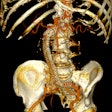Dear Advanced Visualization Insider,
As virtual reality (VR) and augmented reality (AR) continue to make headway in medicine, various groups are proposing new ways to make the technologies as viable as possible for everyday clinical practice.
Researchers from Spain have shown how their proprietary software applications could facilitate the conversion of 3D models based on MRI and CT scans into files compatible with VR and AR devices. They contend that their technique for generating 3D VR and AR models is simpler and cheaper than existing methods.
In our second article posted today in the Advanced Visualization Community, Swiss radiologists laid out the potential advantages that cinematic rendering could offer to clinicians, as well as the host of practical challenges associated with successfully producing these photorealistic images.
The integration of VR and AR into healthcare was the highlight of a Coffee and Talk session dedicated to the topic at the recent ECR 2019 in Vienna. In a series of talks, scientists and physicians from the Netherlands, Sweden, and the U.K. provided insight into the ways in which radiologists could elevate their value by engaging with these advanced visualization modalities.
With the implementation of VR and AR in medicine underway, changes in the approach that physicians take to common tasks is likely to follow, according to educators from Germany. This line of thinking motivated them to incorporate an "AR magic mirror" into an anatomy and radiology education program for medical students in Munich.
3D printing also has made recent advances in several medical specialties, from otolaryngology to radiology:
- An international team of researchers identified more than 700 patient cases involving an ear, nose, or throat condition that benefited from presurgical planning on 3D-printed models.
- Investigators from the German Cancer Research Center created 3D-printed polymer gel phantoms to measure radiation dose distributions during quality assurance tests for radiotherapy treatment.
- At a scientific presentation at ECR 2019, Dr. Philipp Brantner and colleagues from the University Hospital of Basel 3D Printing Lab in Switzerland described how 3D printing could help underscore radiologists' role in the future of medicine.
Stay up to date on the latest news in the field by heading over to the Advanced Visualization Community at AuntMinnieEurope.com.















